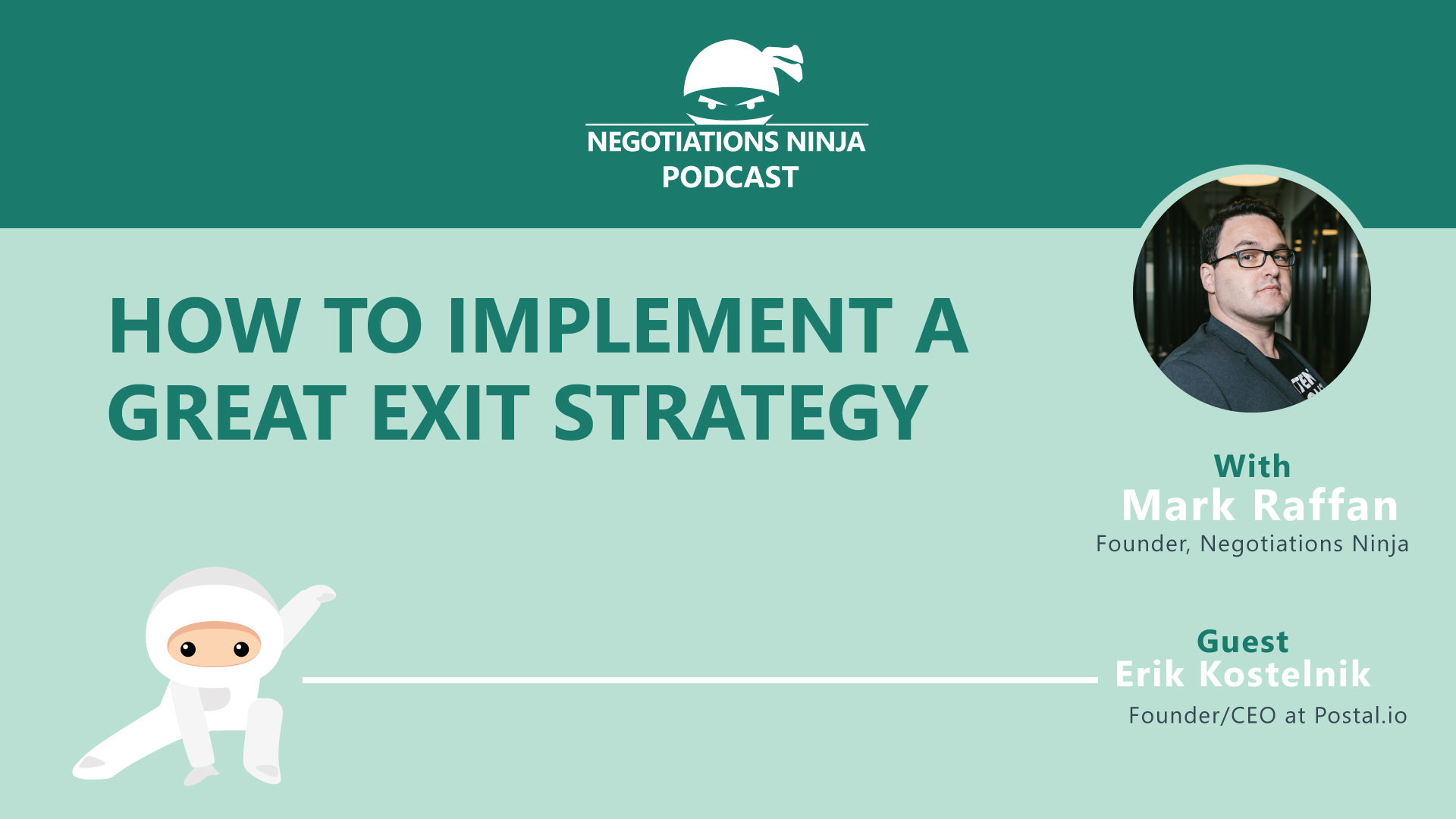How to raise money for a startup is a frequent topic of conversation. But there’s a lot of information lost on the back end of the conversation: how to exit. Do you have an exit strategy for your business? How do you plan an exit? Erik Kostelnik is the founder and CEO of Postal.io. He knows how to negotiate a great exit. Surprisingly, it starts before you even build your business. How? Listen to this episode of the Negotiations Ninja podcast to find out!
Outline of This Episode
- [0:35] How to negotiate a great exit
- [1:42] Erik’s background in tech
- [2:50] The misconceptions about an exit strategy
- [4:41] Building credibility with vendors
- [8:14] How to get vendor conversations
- [12:17] Trust is the key to everything
- [15:12] Create an advisor network to be your extension
- [20:37] The single biggest focus needs to be: start now
The misconceptions about exit strategies
Erik points out that there’s a lot of misinformation out there. Founders tend to say things like “We’re not thinking about an exit” or “An exit’s not in our plan.” But every single founder IS looking for a way to sell their business for more than what it cost them to start. Every venture capitalist out there is looking for a 10x return on their investment. The truth is, it’s all about the exit.
Erik emphasizes “If you’re not positioning your business for an exit when you start the business, then it becomes infinitely more difficult when you try to exit the business.” But how do you start a business with the mindset of exiting it, when you haven’t even raised capital?
First, you ask questions like: Who are the players in your market? What integrations will you have to set up? How are their partners going to provide value or help educate about your platform?
When Erik began to build Postal.io, he started by forming partnerships with major vendors in the HR technology space. He made this a priority from day one. Before they had a product they started conversations and set up meetings. The M&A conversation starts when you start your company.
How to build credibility with your target market
Erik points out you have to identify the deal-makers in your industry or target market. These people need to do anywhere from 1–10 deals a year. They’re interested in learning about the software you’ve created, especially if it’s agnostic. According to Erik, agnostic simply means the software can’t be pinned into a certain category where it comes with big players.
You want to create software that sits on top of the big players (what used to be called “middleware” but is now “integration software”) or services major platforms. In Postal’s case, they can serve HubSpot, Salesforce, Outreach, SalesLoft, and Marketo. Postal knows that they’re the major players and that they don’t have direct mail and offline engagement with their existing platforms.
Erik points out that “You have to understand—if you’re building a solution—how you actually can position yourself as a value add to the existing major players out there.” So you can start putting the bug in their ears: this is what we’re going to do, this is what we focus on, this is what we believe will bring the most benefit to your business.
Once you execute that vision you consistently update them on your number of customers, your revenue, deals being made, etc. You’ve worked to build a relationship, you’ve built trust, and they see you can execute. A good exit then becomes a foregone conclusion. The more conversations you can have early on, the better.
It’s just like the sales process—but it can last 10 years. You just need to ensure that the process is repeatable and that you can establish yourself as a value add. That’s credibility.
How to get conversations with industry players
So how do you start conversations with industry players when you’re a “nobody” in the space? Erik shares that your entity needs to be set up as well as your structure, your ideation, and your build. You have to have a legitimate business, customers, and integration partners. You also need to understand the value that your technology brings to those main players. What is your value proposition? It’s just like any sales process—except you’re selling your business to a corporation.
You then need to identify who the players are at the table—and start prospecting. Go high, deep, and wide. Salesforce has 20 different arms of leadership and 20 different products. Their corp dev is structured so that deal flow comes from their venture capital arm and app exchange. So start to ask the question: what can Salesforce purchase? What companies need the value you have to offer?
Then you find out who makes the decisions and what their strategy is in the decisions that they’ve made in the past. 99.99% of companies don’t have a chance of getting acquired. You want a better shot? Think about what a business is looking for in the next 3–5 years and structure yourself in such a way to be a target.
How is trust the key to a good exit strategy? What is the value of an advisor network? Why do industry relationships matter so much? Listen to the whole episode to glean from Erik’s expertise—and successful exits from four different businesses he’s built.
Resources & People Mentioned
Connect with Erik Kostelnik
Connect With Mark
- Follow Negotiations Ninja on Twitter: @NegotiationPod
- Connect with Mark on LinkedIn
- Follow Negotiations Ninja on LinkedIn
- Connect on Instagram: @NegotiationPod




